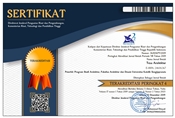POLA SPASIAL KAWASAN PERUMAHAN SERTA KETERSEDIAAN FASILITAS PENDUKUNG DI KECAMATAN CIANJUR
Abstract
The Cianjur District's population has grown over the past ten years, which has raised the demand for livable housing and services to support the daily activities of the residents. This study aims to pinpoint the spatial pattern of residential areas and its impact as well as to ascertain whether Cianjur District has access to facilities for education, health and shopping. This study employed a quantitative descriptive method that combined map overlay analysis techniques with nearest neighbor analysis to analyze spatial patterns. The study's findings indicate that while only seven formal housing complexes available in 2010, there were a total of 29 housing complex were available after ten years. In the Cianjur District, residential land use construction reached 29.70% in 2010 and 49.27% in 2020. Primary school educational facilities are arranged in clusters, junior high schools in dispersion, and high schools in dispersion patterns. The spatial pattern of the puskesmas healthcare facilities is dispersed, with clinics and pharmacies arranged in clustered. All sections of the Cianjur District have access to health facilities' services. However, some formal housing estates have not been covered spatially by pharmacy services. The spatial pattern of shopping facilities is clustered, but residents in Cianjur District can still reach these facilities
Keywords
Full Text:
PDF (Bahasa Indonesia)References
Anam, K., & Warlina, L. (2020). Identifikasi Perubahan Guna Lahan di Desa Cikawung Kecamatan Terisi Kabupaten Indramayu. Jurnal Wilayah dan Kota, 7(1), 10-17. https://doi.org/10.34010/jwk.v7i01.4745
Anastasia, N., Kwanda, T., & Widjaja, D. (2018). Pengaruh Perawatan Prasarana, Sarana, dan Utilitas terhadap Kepuasan Penghuni pada Kawasan Perumahan di Surabaya. Tesa Arsitektur, 16(1), 29 - 39. doi: https://doi.org/10.24167/tesa.v16i1.1153
Badan Standarisasi Nasional. (2004). Standar Nasional Indonesia (SNI) 03-1733-2004 tentang Tata cara perencanaan lingkungan perumahan di perkotaan.
Farhan, Y. & Al-Shawamreh, S. (2019). Impact of Rapid Urbanization and Changing Housing Patterns on Urban Open Public Spaces of Amman, Jordan: A GIS and RS Perspective. Journal of Environmental Protection, 10, 57-79. doi: 10.4236/jep.2019.101005
Febriani, T. (2018). Kajian Perubahan Penggunaan Lahan di Kecamatan Koto Tangah Kota Padang Sumatera Barat. Jurnal Kapita Selekta Geografi, 1(3):17-27.
Gong, P., Li, X., & Zhang, W. (2019). 40-Year (1978–2017) human settlement changes in China reflected by impervious surfaces from satellite remote sensing. Science Bulletin, 64(11), 756–763. https://doi.org/10.1016/j.scib.2019.04.024
Hosseini, A., Farhadi, E., Hussaini, F., Pourahmad, A., & Seraj Akbari, N. (2022). Analysis of spatial (in)equality of urban facilities in Tehran: an integration of spatial accessibility. Environ Dev Sustain 24, 6527–6555. https://doi.org/10.1007/s10668-021-01715-3
Kuswartojo, T. (2010). Mengusik Tata Penyelenggaraan Lingkungan Hidup dan Permukiman. Bandung: Kelompok Keahlian Permukiman dan Perkotaan, SAPPK, ITB.
Lestari, W., & Pratomoatmojo, N. A. (2019). Pemodelan Spasial Prediksi Perkembangan Kawasan Permukiman Berbasis Cellular Automata dengan Pendekatan Kependudukan di Surabaya Timur. Jurnal Teknik ITS, 8(2), 150–155. Doi: http://dx.doi.org/10.12962/j23373539.v8i2.48665
Mardiansjah, F. H., Handayani, W., & Setyono, J. S. (2018). Pertumbuhan Penduduk Perkotaan dan Perkembangan Pola Distribusinya pada Kawasan Metropolitan Surakarta. Jurnal Wilayah dan Lingkungan, 6(3), 215-233. https://doi.org/10.14710/jwl.6.3.215-233
Maclennan, D. & O’Sullivan, T. (2011). Raising the game: the economic case for housing. Edinburgh: Chartered Institute of Housing.
Nata, D. A., Hardati, P., & Arifien, M. (2013). Analisis Ketersediaan dan Pola Sebaran Spasial Fasilitas Kesehatan Terhadap Tingkat Kepuasan Pelayanan Kesehatan Masyarakat di Kecamatan Rembang. Geo Image (Spatial-Ecological-Region), 2(2), 63–71. https://doi.org/10.15294/geoimage.v2i2.2211
Novio, R., Mariya, S., & Wijayanto, B. (2020). The spatial pattern analysis of settlements area in Batusangkar City Tanah Datar Regency. Jurnal Pendidikan Geografi: Kajian, Teori, dan Praktek dalam Bidang Pendidikan dan Ilmu Geografi, 25(1), 80-87. Retrieved from http://journal2.um.ac.id/index.php/jpg/article/view/12009
Pemerintah Republik Indonesia. (1992). Undang-Undang Nomor 4 Tahun 1992 tentang Perumahan dan Permukiman. pada Pasal 1. Jakarta.
Pemerintah Republik Indonesia. (2007). Undang-Undang Nomor 26 Tahun 2007 tentang Penataan Ruang. Jakarta
Pemerintah Republik Indonesia. (2011). Undang-Undang Nomor 1 Tahun 2011 tentang Perumahan dan Kawasan Permukiman.
Peng, Y., & Wang, Q. (2020). Spatial distribution and influencing factors of settlements in the farming–pastoral ecotone of Inner Mongolia, China. Ecosystem Health and Sustainability, 6(1), 1–8. https://doi.org/10.1080/20964129.2020.1771213
Prasetyo, A. (2016). Pola Spasial Penjalaran Perkotaan Bodetabek: Studi Aplikasi Model Shannon’s Entropy. Jurnal Geografi Gea, 16(2), 144-160. doi: https://doi.org/10.17509/gea.v16i2.2439
Pratama, A., Roychansyah, S., & Hergawati, Y. (2020). Dampak Perkembangan Perumahan terhadap Masyarakat di Sekitar Perumahan Kecamatan Baruga, Kota Kendari. Jurnal Planoearth, 5(1), 25–34. https://doi.org/10.31764/jpe.v5i1.1652
Setyono, D. A., Hariyani, S., Cahyono, D. D., & Helmy, M. (2017). Spatial Patterns of Public Facility Services based on Grid/Cell Supply Approach (Case Study: Elementary School in Malang, Surakarta & Banjarmasin City). In M. A. B. Abdullah, S. Z. Abd Rahim, M. E. Muhammad Suandi, M. N. Mat Saad, & M. F. Ghazali (Eds.), MATEC Web of Conferences, 97, 1-11. https://doi.org/10.1051/matecconf/20179701063
Yunita, P., & Sari, W. N. (2019). Pengembangan Perumahan dan Kawasan Permukiman Kota Malang dalam Dualisme Spatial – Non Spatial. Jurnal Spasial, 6(2), 50–61. https://doi.org/10.22202/js.v6i2.3740
Warlina, L., Aulia, N., Hakim, K., Nuraeni, N., & Dewi, N. (2022). Impact of Population Density on Physical Environmental Quality. Tesa Arsitektur, 19(2), 97-102. doi: https://doi.org/10.24167/tesa.v19i2.3400
Warlina, L., & Damayanty, L. (2021). The Expansion and Spatial Pattern of Shopping and Tourism Services Facilities in North Bandung Region, Indonesia. Indonesian Journal of Science and Technology, 6(2), 385–400. https://doi.org/10.17509/ijost.v6i2.35105
DOI: https://doi.org/10.24167/tesa.v21i1.5216
ISSN 1410-6094 (Print) | ISSN 2460-6367 (Media Online) | View My Stats

This work is licensed under a Creative Commons Attribution 4.0 International License.









